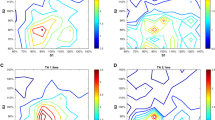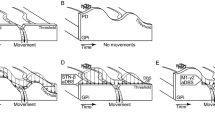Abstract
Voluntary movements in Parkinson's disease are initiated and executed slowly1,2. It is assumed that the motor cortex and its output pathway are intact and that bradykinesia is due to abnormal motor commands delivered to a normal corticospinal system. We have tested this assumption using electrical stimulation of the motor cortex through the scalp in three patients with severe Parkinson's disease, studied during fluctuations from relatively normal mobility when receiving drugs (ON) to severe bradykinesia when not receiving drugs (OFF). Thresholds and latencies for motor cortex stimulation to excite thumb flexor muscles and the resulting fast mechanical responses were the same in both ON and OFF conditions, even though the patients were unable to execute fast thumb flexion movements voluntarily when OFF. We conclude that the excitability and conduction velocity of the corticospinal motor pathways are normal in Parkinson's disease.
This is a preview of subscription content, access via your institution
Access options
Subscribe to this journal
Receive 51 print issues and online access
$199.00 per year
only $3.90 per issue
Buy this article
- Purchase on Springer Link
- Instant access to full article PDF
Prices may be subject to local taxes which are calculated during checkout
Similar content being viewed by others
References
Parkinson, J. An Essay on the Shaking Palsy (Sherwood, Nealy and Jones, London, 1817).
Draper, I. T. & Johns, R. J. Bull. Johns Hopkins Hosp. 115, 465–480 (1964).
Merton, P. A. & Morton, H. B. Nature 285, 227–228 (1980).
Merton, P. A. & Morton, H. B. J. Physiol., Lond. 305, 9–10P (1980).
Merton, P. A., Hill, D. K., Morton, H. B. & Marsden, C. D. Lancet ii, 597–600 (1982).
Hill, D. K., McDonnell, M. J. & Merton, P. A. J. Physiol., Lond. 300, 2–3P (1980).
Hoehn, M. M. & Yahr, D. Neurology, Minneap. 17, 427–442 (1967).
Marsden, C. D., Merton, P. A. & Morton, H. B. J. Physiol., Lond. 328, 6P (1982).
Phillips, C. G. Q. Jl. exp. Physiol. 41, 70–84 (1956).
Asanuma, H. & Sakata, H. J. Neurophysiol. 30, 35–54 (1967).
Phillips, C. G. & Porter, R. Corticospinal Neurones, 84–85 (Academic, New York, 1977).
Landau, W. M., Bishop, G. H. & Clare, M. H. J. Neurophysiol. 28, 1206–1222 (1965).
Marsden, C. D., Merton, P. A. & Morton, H. B. J. Physiol., Lond. 312, 5–6P (1980).
Lindvall, O., Bjorklund, A. & Skagberg, G. Ann. Neurol. 14, 255 (1983).
Author information
Authors and Affiliations
Rights and permissions
About this article
Cite this article
Dick, J., Cowan, J., Day, B. et al. The corticomotoneurone connection is normal in Parkinson's disease. Nature 310, 407–409 (1984). https://doi.org/10.1038/310407a0
Received:
Accepted:
Issue Date:
DOI: https://doi.org/10.1038/310407a0
This article is cited by
-
Urinary tract dysfunction in Parkinson’s disease: a review
International Urology and Nephrology (2012)
-
Intercentral relations under the effect of atypical and typical neuroleptics
Bulletin of Experimental Biology and Medicine (1999)
-
Wilson's disease: normalisation of cortically evoked motor responses with treatment
Journal of Neurology (1991)
Comments
By submitting a comment you agree to abide by our Terms and Community Guidelines. If you find something abusive or that does not comply with our terms or guidelines please flag it as inappropriate.



